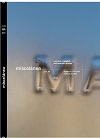The Multidirectionality of Memory: Networks of Trauma in Post-9/11 Literature
DOI:
https://doi.org/10.26754/ojs_misc/mj.20148777Resumen
La literatura de ficción sobre el 11-S muestra una sorprendente tendencia a conjurar otros traumas y referencias intertextuales históricas en un marco asociativo que introduce en los textos una oscilación entre la representación narrativa y la referencia indicial, y que ejemplificaré en una lectura de Extremely Loud & Incredibly Close, de J.S. Foer, e In the Shadow of No Towers, de Art Spiegelman. Partiendo de una comprensión del trauma como estructura de recepción más que como fenómeno esencialmente vinculado a acontecimientos específicos, en este artículo el trauma emerge no sólo como marco interpretativo para abordar la estética y la psicología de la ficción posterior al 11-S, sino también como vínculo intercultural y diacrónico con el que experimenta la literatura de ficción. Trabajando con el modelo de memoria colectiva multidireccional desarrollado por Michael Rothberg, esta cualidad específica de intertextualidad y diálogo intergeneracional da lugar a la impresión de que la memorialización de los atentados terroristas del 11 de septiembre de 2001 funciona de un modo más dinámico de lo que parece a priori. En este contexto contemporáneo, el trauma literario no surge como un vacío irrepresentable, sino que debe describirse en términos de un espacio intermedio productivo, aunque liminal, tanto del recuerdo individual y cultural como de la representación estética.
Descargas
Referencias
ADORNO, Theodor W. 1969. Kulturkritik und Gesellschaft. Frankfurt am Main: Suhrkamp.
ASSMAN, Aleida. 2006. Erinnerunsräume. München: C.H. Beck.
BARTHES, Roland. 1980. La Chambre Claire. Note sur la Photographie. Paris: Gallimard.
BENJAMIN, Walter. (1936) 1999. “The Storyteller. Reflections on the Works of Nikolai Leskov”. In Arendt, Hannah. (ed.) Illuminations. London: Pimlico: 83-110.
BORRADORI, Giovanna. 2003. Philosophy in a Time of Terror. Dialogues with Jürgen Habermas and Jacques Derrida. Chicago: University of Chicago Press.
CARUTH, Cathy. (ed.). 1995. Trauma. Explorations in Memory. Baltimore: Johns Hopkins U.P.
CARUTH, Cathy. 1996. Unclaimed Experience. Trauma, Narrative and History. Baltimore: Johns Hopkins U.P.
—. 2002. “An interview with Jean Laplanche”. In Belau, Linda (ed.). Topologies of Trauma. Essays on the Limit of Knowledge and Memory. New York: Other Press: 101-126.
CVEK, Sven. 2011. Towering Figures. Reading the 9/11 Archive. Amsterdam/New York: Rodopi.
DAVIS, Walter A. 2006. Death’s Dream Kingdom. The American Psyche since 9-11. London: Pluto Press.
FOER, Jonathan Safran. (2005) 2006. Extremely Loud & Incredibly Close. London: Penguin.
FREUD, Sigmund. (1939) 1970. Der Mann Moses und die monotheistische Religion. Frankfurt am Main: Suhrkamp.
—. (1892) 1966. “Zur Theorie des Hysterischen Anfalls”. In Freud, Anna. (ed.). Sigmund Freud. Gesammelte Werke. Band XVII: Schriften aus dem Nachlass. Frankfurt am Main: S. Fischer Verlag: 9-13.
HOROWITZ, Mardi. (ed.). 1999. Essential Papers on Posttraumatic Stress Disorder. New York/London: New York U.P.
KÜHNER, Angela. 2003. Kollektive Traumata. Konzepte, Argumente, Perspektiven. Berlin: Berghof-Forschungszentrum für Konstruktive Konfliktbearbeitung.
LACAPRA, Dominick. 2001. Writing History, Writing Trauma. Baltimore: Johns Hopkins U.P.
LAUB, Dori. 2002. “September 11, 2001 —An Event without a Voice”. Trauma Research Net Newsletter 2. <http://www.traumaresearch.net/net2/forum2/laub.htm>. Accessed June 5, 2013.
LYOTARD, Jean-Francois. (1988) 2005. Heidegger und “die Juden”. Ed. Engelmann, P. Trad. C-C. Härle. Wien: Passagen-Verlag.
PEIRCE, Charles S. (1895) 1998. Of Reasoning in General. Ed. N. Houser. “The Essential Peirce”, Vol. 2 (1893-1913). Bloomington and Indianapolis: Indiana U.P.
RAPAPORT, Herman. 2002. “Representation, History, and Trauma: Abstract Art after 1945”. In Belau, L and P. Ramadanovic (ed.). Topologies of Trauma. Essays on the Limit of Knowledge and Memory. New York: Other Press.: 233-250.
REDFIELD, Marc. 2009. The Rhetoric of Terror. Reflections on 9/11 and the War on Terror. New York: Fordham U.P.
RICOEUR, Paul. 1986. The Rule of Metaphor. Multi-Disciplinary Studies of the Creation of Meaning in Language. London: Routledge.
ROTHBERG, Michael. 2009. Multidirectional Memory. Remembering the Holocaust in the Age of Decolonization. Standford, California: Standford U.P.
SAAL, Ilka. 2011. “Regarding the Pain of Self and Other: Trauma Transfer and Narrative Framing in Jonathan Safran Foer’s Extremely Loud & Incredibly Close”. Modern Fiction Studies vol. 57-3: 453-476.
SEBALD, W.G. 2003. On the Natural History of Destruction. New York: Random House.
SPIEGELMAN, Art. 2004. In The Shadow of No Towers. New York: Pantheon.
VERSLUYS, Kristiaan. 2009. Out of the Blue. September 11 and the Novel. New York: Columbia Press.
WHITEHEAD, Anne. 2004. Trauma Fiction. Edinburgh: Edinburgh U.P.
Descargas
Publicado
Número
Sección
Licencia
Derechos de autor 2014 Katharina Donn

Esta obra está bajo una licencia internacional Creative Commons Atribución-NoComercial 4.0.


